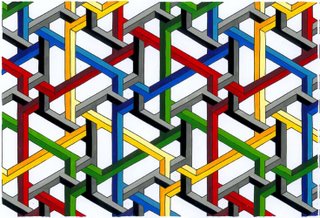In Rome , there are several wonderful examples of how Renaissance and Baroque artists were beginning to re-learn the lessons of perspective, which, had been discarded during the medieval period while artists focused on the social and religious dimensions of art.
Realistic perspective in paintings requires artists to understand a lot about the human vision system. If you can accurately portray perspective, you might just be able to build a jumbo-sized cathedral on a moderate-sized budget.
The most ambitious attempt at this could be the church of Sant’Ignazio di Loyola of Rome. Looking at this detail from the church’s ceiling, you almost believe that it ascends to infinity.(picture above)
Unfortunately, the illusion only works from one point in the church. Once you start to move around, the illusion breaks down. Take a look at this view from under the church’s “dome”:
The formerly “straight” column is now awkwardly bent, revealing the artist’s clever deception. The ceiling of the church is actually nearly flat.
But the church designers saved big bucks with this design: a few painters are always cheaper than legions of stoneworkers and masons.
An even more impressive illusion was achieved in the Palazzo Spada, where the architect Francesco Borromini designed a columned passage to appear 35 meters long when it was in fact just 8 meters in length:
The floor of the hallway slopes upward, and the ceiling and walls converge. Even the “hedges” at the end of the hall are miniaturized, as is the sculpture in the center. Unfortunately the museum didn’t let visitors walk up the hallway for action photos, so I had to generate this picture from a postcard after the fact.
Filed under: 3D illusion, art, artists, effects | Tagged: art, optical illusions, perspective, Sculptures | Leave a comment »









